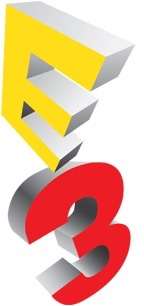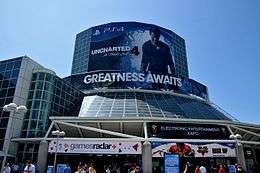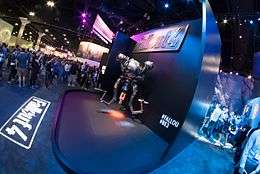Electronic Entertainment Expo
| Electronic Entertainment Expo | |
|---|---|
 | |
| Status | Active |
| Genre | Video games |
| Venue | Los Angeles Convention Center |
| Location(s) | Los Angeles, California, U.S. |
| Country | United States |
| Inaugurated | May 11, 1995 |
| Most recent | June 14, 2016 |
| Attendance | 50,300 (2016)[1] |
| Organized by | Entertainment Software Association |
| Website | |
| https://www.e3expo.com/ http://www.e3insider.com | |


The Electronic Entertainment Expo, commonly known as E3, is an annual trade fair for the video game industry presented by the Entertainment Software Association (ESA). It is used by many video game publishers and accessory manufacturers to introduce and advertise upcoming games and game-related merchandise. Unlike Gamescom and other video-game trade fairs open to the public, E3 is an industry-only event;[2] individuals who wish to attend are required by the ESA to verify a professional connection to the video-game industry.
E3 is usually held in late May or early June at the Los Angeles Convention Center (LACC) in Los Angeles; the most recent event was held from June 14–16, 2016. The show in 2017 will be held from June 13–15, 2017.
History
Before E3, game publishers went to other trade shows to display new or upcoming products; these include the Consumer Electronics Show (CES) and the European Computer Trade Show. As the game industry grew rapidly during the early 1990s, industry professionals felt that it had outgrown the older trade shows. According to Tom Kalinske, CEO of Sega America, "The CES organizers used to put the video games industry way, way in the back. In 1991 they put us in a tent, and you had to walk past all the porn vendors to find us. That particular year it was pouring rain, and the rain leaked right over our new Genesis system. I was just furious with the way CES treated the video games industry, and I felt we were a more important industry than they were giving us credit for." Sega did not return to the CES the following year, and with the founding of the Interactive Digital Software Association (IDSA) in 1994 most other game companies followed suit.[3]
The first E3 was conceived by IDG's Infotainment World and co-founded by the Interactive Digital Software Association (now the ESA). It coincided with a new generation of consoles, the release of the Sega Saturn, and announcements of the upcoming PlayStation, Virtual Boy and Neo-Geo CD. Although specifications for the Nintendo Ultra 64 (later renamed Nintendo 64) were released, no hardware was displayed.[4] According to Eliot Minsker, chairman and CEO of Knowledge Industry Publications (which produced and promoted the show with Infotainment World), "Retailers have pointed to the need for an interpretive event that will help them make smarter buying decisions by interacting with a wide range of publishers, vendors, industry influentials, and opinion leaders in a focused show setting."[5]
Although the IDSA asked the CES for private meeting space for game developers, it was told that access could not be limited. Patrick Ferrell, CEO of IDG's Infotainment World, sent his vice president of marketing to the meeting; when Ferrell received the CES' reply, Infotainment World management announced E3. Needing full industry support, Ferrell negotiated an agreement between IDG and the IDSA and they co-produced the show for several years.
The first event was held from May 11–13, 1995 in Los Angeles.[6] Keynote speakers included Sega of America president and CEO Thomas Kalinske, Sony Electronic Publishing president Olaf Olafsson, and Nintendo of America chairman Howard Lincoln.[7] It was one of the largest trade-show debuts in history, with 700,000 square feet (65,000 m2) of exhibit space and over 48,900 attendees.
Online presence
In addition to the event, E3 has supported (or is associated with) several websites. One was E365, introduced in 2006,[8] an online community which attendees used to network and schedule meetings.
Tokyo '96
In 1996, IDG and the IDSA tried a Japanese version of E3, in preparation for a worldwide series of events, at the Makuhari Messe in Tokyo (as E3 Tokyo '96) in association with TV Asahi. Although Sony Computer Entertainment was the show's original sponsor, the company withdrew its support in favor of its PlayStation Expo. Sega pulled out at the last minute, leaving Nintendo the only big-three company to appear. Held November 1–4, 1996, the presence of several other gaming expos and lack of support from Japanese game manufacturers led to turnout reported as "poor" and rumored E3 events in Singapore and Canada did not take place.[9]
See also
- List of gaming conventions
- Gamescom
- Tokyo Game Show
- Gamercom
- Consumer Electronics Show
- Game Developers Conference
References
- ↑ Sarkar, Samit (June 16, 2016). "E3 2016 attendance down slightly, E3 2017 dated". Polygon. Retrieved June 16, 2016.
- ↑ "E3 is Obsolete, But it Doesn't Matter". Forbes. 2012-06-08. Retrieved 2012-10-18.
- ↑ Dring, Christoffer (2013-07-11). "A Tale of Two E3s - Xbox vs Sony vs Sega". MCV.
- ↑ Varanini, Giancarlo. "E3: Past, Present, and Future". Gamespot. Retrieved June 16, 2016.
- ↑ "Atlanta Chosen as Site for New Trade Show". GamePro (56). IDG. March 1994. p. 186.
- ↑ "E3 Replaces Summer CES". GamePro (66). IDG. January 1995. p. 211.
- ↑ "E3 on Track". GamePro. IDG (69): 146. April 1995.
- ↑ "E365". Archived from the original on 2007-10-13.
- ↑ "任天堂もSEGAもSONYもいないE3/Tokyo'96". PC Watch. 1996-11-01. Retrieved 2011-04-12.
- Callaham, John (2007-06-19). "Looking back at E3". FiringSquad. Retrieved 2007-06-22.
External links
| Wikimedia Commons has media related to Electronic Entertainment Expo. |